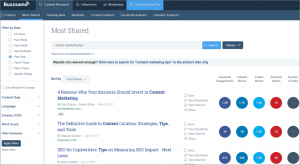
 As a 21st century marketer, you already know that data is an important player in the content marketing game. Data helps us understand who our audience is, what they care about, and how our content impacts their decisions. It helps us connect all the dots — and continue to find new dots as attitudes, needs, and preferences change. But is your content marketing strategy taking advantage of all of the data you have at your disposal? Or is some data left on the cutting room floor? As TopRank Marketing’s own Lee Odden recently wrote on the topic of data-informed content marketing:
As a 21st century marketer, you already know that data is an important player in the content marketing game. Data helps us understand who our audience is, what they care about, and how our content impacts their decisions. It helps us connect all the dots — and continue to find new dots as attitudes, needs, and preferences change. But is your content marketing strategy taking advantage of all of the data you have at your disposal? Or is some data left on the cutting room floor? As TopRank Marketing’s own Lee Odden recently wrote on the topic of data-informed content marketing:
“When it comes to content, creators are traditionally more art than science, and using data to guide editorial planning is still not an advanced skill for many companies.”Not too long ago, Forrester reported that companies only use 12% of the data they have at their disposal. The remaining 88% of data is wasted and left unused. But imagine how much more effective your content marketing efforts would be if you upped that percentage even a few points — let alone to 100%. With that said, we want to help you up your data gleaning skills and get the most out of your search, social, and behavioral data. Below are our top tips for becoming a better data-informed content marketer and really boost your content performance.
#1 - Create a segmented content pipeline.
Odds are, you already track your customers, the pages they visit, how long they stay, and the actions they take on your site. After all, it’s Content Marketing 101 to track your audience and their behavior, but this doesn’t paint a complete picture of your content and how it’s performing. To get a complete, 360-degree picture, you need to analyze the types of content you’re creating and draw some conclusions about performance. Start breaking down your content by bucketing your pieces by length, stage of the funnel, topic, keyword, and other categories that could influence audiences. You can typically find this information in your content management system (CMS), content marketing platform (CMP), or your editorial calendar. At TopRank Marketing, we’ve developed our own dashboard that integrates with various data sources such as Google Analytics and Google Search Console, as well as pulls in our own categories and details to help us segment and analyze how our own content, as well as the content within our client programs, is performing. Here’s a little peek at how we segment: Once your content has been segmented, it’s not only easier to see what types of content perform best, but also when they reach their peak performance and with whom. If a pattern starts to emerge, you can then fill up your content pipeline with items that can replicate that same success. [bctt tweet="Use the #data at your fingertips to create a segmented content pipeline. - @aleuman4 #contentmarketing" username="toprank"]
Once your content has been segmented, it’s not only easier to see what types of content perform best, but also when they reach their peak performance and with whom. If a pattern starts to emerge, you can then fill up your content pipeline with items that can replicate that same success. [bctt tweet="Use the #data at your fingertips to create a segmented content pipeline. - @aleuman4 #contentmarketing" username="toprank"]
#2 - Monitor social activity and engagement.
Of the world’s 3.7 billion internet users, 2.7 billion of them are active social media users, according to We Are Social. That’s roughly 35% of the world’s population logging onto social media to discover trending content and share messages with their networks. With that in mind, using social media to distribute your content is a no-brainer. Plus, social networks make it easy for your to track your content’s social engagement through likes, retweets, shares, mentions, replies, etc. But your own social media profiles and posts aren’t the only thing you should be monitoring if you want to create a more data-informed content strategy. Because social is such an important marketing channel, your competition and industry thought leaders will be on social as well. Monitoring their profiles and content, as well as your own, using tools like BuzzSumo or Follwerwonk can help you discover what types of content is really resonating and identify gaps in your own content plan. It’s also a good idea to take a look at your top followers and customers on social to see what types of content they like and share with their own followers. With this data in hand, you can create content that is more suited to their interests, increasing your social engagement. Read: 12 Industry-Specific Opportunities for Boosting Social Media Engagement
It’s also a good idea to take a look at your top followers and customers on social to see what types of content they like and share with their own followers. With this data in hand, you can create content that is more suited to their interests, increasing your social engagement. Read: 12 Industry-Specific Opportunities for Boosting Social Media Engagement
#3 - Refine and create new audience segments.
How are your current audience segments built? More often than not, they’re bucketed based off of demographic data. But your audiences are more than their age, location, or gender. They’re real people with real interests that you can use to your marketing advantage. You just have to find them first. Deliver more relevant content to your customers by further drilling down your audience segments beyond what Google Analytics’ Audience Overview provides. For example, after performing a deep dive into your Google Analytics, social, email, and transactional data, you can perform new segmentation based on where each person is in the funnel, the types of content they’ve engaged in, what they’ve purchased, shared, etc. Your audiences should never be set in stone, either. People change over time and your audience segments should, too. With new audience segments formed with specific criteria, you have more opportunities to create content tailored just for them, improving your engagement rate. [bctt tweet="Your audiences are more than their age, location, or gender. - @aleuman4 #contentmarketing #data" username="toprank"]#4 - Use behavioral data to find what’s valuable.
When creating a nurture campaign or onboarding experience, it’s tempting to throw everything in your arsenal at your audience. This way they have everything they need to know to make a decision, right? The problem with this approach is that “everything” probably isn’t relevant to them. To really get a sense for what matters to each of your audience segments, take a look at your customers’ past behaviors and actions. In analyzing your past campaigns, is there a common touchpoint where customers dropped out or converted? If so, it’s your job to determine what contributed to or influenced this behavior. Was it the content, timing, or cadence? This practice will help you identify what your audience finds valuable and allow you to create campaigns that only present relevant and helpful information. Read: 6 Best Practices for Nurturing B2B Marketing Qualified Leads#5 - Repurpose and redeploy what didn’t work.
Failure is really just a masked opportunity. Part of being a data-informed marketer is taking information from what worked and what didn’t. If something failed to engage an audience or drive conversions, that is an opportunity to rework and improve — not throw something away and start fresh. Repurposing your content is not only sustainable, but it also has the chance to improve your reach, engagement, completed calls to action, and more. Instead of scraping content that might have flopped or didn’t get the social engagement you were aiming for, dig deeper into the data to find what part of your content didn’t work. If no one clicked on your content to begin with, fixing the problem could be as simple as updating your promotional messages (e.g. emails, social messages, etc.) or meta description and title tags. Alternatively, if readers are exiting your content early, you may need to add more meat to your content to pique their interest and keep them reading longer. The bottom line is that there is no such thing as bad results — even a “bad” result can tell you an awful lot about what’s happening with your content. [bctt tweet="Failure is really just a masked opportunity. - @aleuman4 #contentmarketing #data" username="toprank"]Eliminate Your Content Outliers
By using the advice above, you can begin to create an effective content marketing strategy that works and weed out the practices that don’t. Get a jump start on removing those bad habits by removing these five outdated content marketing tactics from your playbook.The post How to Become a Better Data-Informed Content Marketer appeared first on Online Marketing Blog - TopRank®.
No comments:
Post a Comment